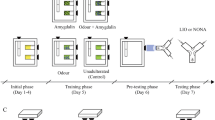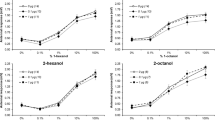Abstract
Due to the changing behavioral contexts at which social insects are exposed during the adult lifespan, they are ideal models to analyze the effect of particular sensory stimuli during young adulthood on later behavior. Specifically, our goal is to understand early influences on later foraging behavior. For that, olfactory memories were established by worker honeybees to different pre-foraging ages using either (1) classical conditioning in the proboscis extension response (PER) paradigm or (2) the offering of scented-sugar solution under different rearing conditions. By testing long-term memories (LTM) through a single PER test in workers of foraging ages (17–25 days), we found that retention of the early olfactory memories in honey bees is age-dependent and not time-dependent. Independently of the environmental conditions in which they were reared (laboratory cages or hives), bees were able to retain food-odor association from 5 days after emergence, but rarely before. In most experiments we observed a bi-modal pattern of response: bees exposed to scented-food at 5–8 and 13–16 days showed better retention than those exposed at 9–12 days. These differences disappeared for bees reared in hives. Retrieval of LTMs depending on the timing and the continuous inputs of appropriate sensory stimuli are discussed.







Similar content being viewed by others
Abbreviations
- PER:
-
Proboscis extension response
- CS:
-
Conditioned stimulus
- LTM:
-
Long-term memory
- PHE:
-
Phenylacetaldehyde
- CR:
-
Conditioned responses
- US:
-
Unconditioned stimulus
- LIO:
-
Linalool
References
Arenas A, Fernández VM, Farina WM (2007) Floral odor learning within the hive affects honeybees’ foraging decisions. Naturwissenschaften 94:218–222
Ben-Shahar Y, Thompson CK, Hartz SM, Smith BH, Robinson GE (2000) Differences in performance on a reversal learning test and division of labor in honey bee colonies. Anim Cogn 3:119–125
Bhagavan S, Benatar S, Cobey S, Smith BH (1994) Effect of genotype but not of age or caste on olfactory learning performance in the honey bee, Apis mellifera. Anim Behav 48:1357–1369
Bitterman ME, Menzel R, Fietz A, Schaefer S (1983) Classical conditioning of proboscis extension in honeybees. J Comp Physiol A 97:107–119
Bloch G, Sullivan P, Robinson G (2002) Juvenile hormone and circadian locomotor activity in the honey bee Apis mellifera. J Insect Physiol 48:1123–1131
Caubet Y, Jaisson P, Lenoir A (1992) Preimaginal induction of adult behaviour in insects. Q J Exp Psychol B 44:165–178
Collins A (1980) Effect of age on the response to alarm pheromones by caged honeybees. Ann Entomol Soc Am 73:307–309
Cornwell-Jones CA, Velasquez P, Wright EL, McGaugh JL (1988) Early experience influences adult retention of aversively motivated tasks in normal, but not DSP4-treated rats. Dev Psychobiol 21:177–185
Cramer CP, Pfister JP, Haig KA (1988) Experience during suckling alters later spatial learning. Dev Psychobiol 21:1–24
Farina WM, Grüter C, Díaz PC (2005) Social learning of floral odours inside the honeybee hive. Proc R Soc Lond B 272:1923–1928
Farina WM, Grüter C, Acosta LE, McCabe S (2007) Honeybees learn floral odors while receiving nectar from foragers within the hive. Naturwissenschaften 94:55–60
Farris SM, Robinson GE, Fahrbach SE (2001) Experience- and age-related outgrowth of intrinsic neurons in the mushroom bodies of the adult worker honeybee. J Neurosci 21(16):6395–6404
Gerber B, Wüstenberg D, Schütz A, Menzel R (1998) Temporal determinants of olfactory long-term retention in honeybee classical conditioning: nonmonotonous effects of the training trial interval. Neurobiol Learn Mem 69:71–78
Gil M, De Marco RJ (2005) Olfactory learning by means of trophallaxis in Apis mellifera. J Exp Biol 208:671–680
Grüter C, Acosta LE, Farina WM (2006) Propagation of olfactory information within the honeybee hive. Behav Ecol Sociobiol 60:707–715
Gschanes A, Eggenreich U, Windisch M, Crailsheim K (1998) Early postnatal stimulation influences passive avoidance behaviour of adult rats. Behav Brain Res 93:91–98
Hammer M (1993) An identified neuron mediates the unconditioned stimulus in associative olfactory learning in honeybees. Nature 366:59–63
Hammer M, Menzel R (1995) Learning and memory in the honeybee. J Neurosci 15(3):1617–1630
Huang ZY, Plettner E, Robinson GE (1998) Effects of social environment and worker mandibular glands on endocrine-mediated endocrinal behavioral development in honey bees. J Comp Physiol A 183:143–152
Ichikawa N, Sasaki M (2003) Importance of social stimuli for the development of learning capability in honeybee. Appl Entomol Zool 38:203–209
Jassim O, Huang ZY, Robinson GE (2000) Juvenile hormone profiles of worker honey bees, Apis mellifera, during normal and accelerated behavioural development. J Insect Physiol 46:243–249
Laloi D, Gallois M, Roger B, Pham-Delègue MH (2001) Changes with age in olfactory conditioning performance of worker honey bees (Apis mellifera). Apidologie 32:231–242
Lindauer M (1952) Ein Beitrag zur Frage der Arbeitsteilung im Bienenstaat. Z Vgl Physiol 34:299–345
Lorenz K (1935) Der Kumpan in der Umwelt des Vogels. Zeitschrift für Ornithologie 83:137–213. 289–413
Maleszka R, Helliwell P (2001) Effect of juvenile hormone on short-term olfactory memory in young honeybees (Apis mellifera). Horm Behav 40:403–408
Masson C, Arnold G (1984) Ontogeny, maturation and plasticity of the olfactory system in the worker bee. J Insect Physiol 30:7–14
Masson C, Arnold G (1987) Organization and plasticity of the olfactory system of the honeybee, Apis mellifera. In: Menzel R, Mercer A (eds) Neurobiology and behavior of honeybee. Springer, Berlin, pp 280–295
Masson C, Pham-Delègue MH, Fonta C, Gascuel J, Arnold G, Nicolas G, Kerszberg M (1993) Recent advances in the concept of adaptation to natural odour signals in the honeybee Apis mellifera L. Apidologie 24:169–194
Matthews K, Robbins TW (2003) Early experience as a determinant of adult behavioural responses to reward: the effects of repeated maternal separation in the rat. Neurosci Biobehav Rev 27:45–55
Menzel R (1999) Memory dynamics in the honeybee. J Comp Physiol A 185:323–340
Mery F (2007) Aging and its differential effects on consolidated memory forms in Drosophila. Exp Gerontol 42:99–101
Morgan SM, Butz Huryn VM, Downes SR, Mercer AR (1998) The effects of queenlessness on the maturation of the honey bee olfactory system. Behav Brain Res 91:115–126
Pankiw T, Page R Jr (2003) Effect of pheromones, hormones, and handling on sucrose response thresholds of honey bees (Apis mellifera L.). J Comp Physiol A 189:675–684
Pham-Delègue MH, Roger B, Charles R, Masson C (1990) Effet d′une prè-exposition olfactive sur un comportement d′orientation en olfactomètre dynamique a quatre voies chez l′abeille (Apis mellifera L.). Insectes Soc 37:181–187
Pham-Delègue MH, Masson C, Etievant P (1991) Allelochemical mediated forging behaviour: the bee-sunflower model. In: Goodman LJ, Fisher RC (eds) Behaviour and physiology of bees. CAB International, Wallingford, pp 163–184
Pryce CR, Feldon J (2003) Long-term neurobehavioural impact of the postnatal environment in rats: manipulations, effects and mediating mechanisms. Neurosci Biobehav Rev 27:57–71
Ray S, Ferneyhough B (1997) The effects of age on olfactory learning and memory in the honey bee Apis mellifera. Neuroreport 8:789–793
Ray S, Ferneyhough B (1999) Behavioral development and olfactory learning in the honeybee (Apis mellifera). Dev Psychobiol 34:21–27
Robinson G (1992) Regulation of division of labor in insect societies. Ann Rev Entomol 37:637–665
Robinson G, Vargo E (1997) Juvenile hormone in adult eusocial Hymenoptera: gonadotropin and behavioral pacemaker. Arch Insect Biochem Physiol 35:559–583
Rösch GA (1925) Untersuchungen über die Arbeitsteilung im Bienenstaat. Z Vgl Physiol 2:571–631
Schäble S, Poeggel G, Braun K, Gruss M (2007) Long-term consequences of early experience on adult avoidance learning in female rats: role of the dopaminergic system. Neurobiol Learn Mem 87:109–122
Scheiner R, Page RE Jr, Erber J (2001) The effects of genotype, foraging role, and sucrose responsiveness on the tactile learning performance of honey bees (Apis mellifera L.). Neurobiol Learn Mem 76:138–150
Seeley TD (1982) Adaptive significance of the age polytheism schedule in honeybee colonies. Behavl Ecol Sociobiol 11(4):287–293
Sengpiel F (2007) The critical period. Curr Biol 7(4):R742–R743
Sokal RR, Rohlf FJ (1995) Biometry: the principles and practice of statistics in biological research. State University of New York, New York, p 715
Spivak M, Masterman R, Ross R, Mesce KA (2003) Hygienic behavior in the honey bee (Apis mellifera L.) and the modulatory role of octopamine. J Neurobiol 55:341–354
Takeda K (1961) Classical conditioned response in the honey bee. J Insect Physiol 6:168–179
Thorpe WH (1939) Further studies on preimaginal conditioning in insects. Proc R Soc Lond B 127:424–433
Vergoz V, Roussel E, Sandoz JC, Giurfa M (2007) Aversive learning in honeybees revealed by the olfactory conditioning of the sting extension reflex. PLoS ONE 2(3): e288. doi:10.1371/journal.pone.0000288
von Frisch K (1968) The role of dances in recruiting bees to familiar sites. Anim Behav 16:531–533
Winnington A, Napper RM, Mercer AR (1996) Structural plasticity of identified glomeruli in the antennal lobes of the adult worker honey bee. J Comp Neurol 365:479–490
Acknowledgments
We are grateful to V. M. Fernandez for her support during the experiments with free-flying bees. We are also indebted to R. Josens, S. Mc Cabe and two anonymous referees for their valuable comments and suggestions on an early version of this manuscript. This study was supported by funds from ANPCYT (01-12319) and University of Buenos Aires (X 036). The experiments comply with the “Principles of animal care”, publication No. 86-23, revised 1985 of the National Institute of Health, and also with the current laws of the country in which the experiments were performed.
Author information
Authors and Affiliations
Corresponding author
Rights and permissions
About this article
Cite this article
Arenas, A., Farina, W.M. Age and rearing environment interact in the retention of early olfactory memories in honeybees. J Comp Physiol A 194, 629–640 (2008). https://doi.org/10.1007/s00359-008-0337-z
Received:
Revised:
Accepted:
Published:
Issue Date:
DOI: https://doi.org/10.1007/s00359-008-0337-z




